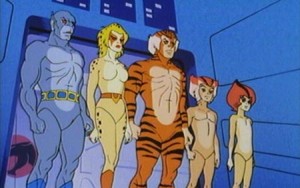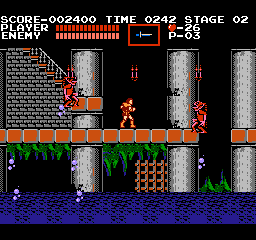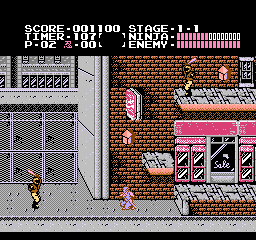
Nostalgia is a very powerful force. It’s what makes Thundercats seem like one of the awesomest shows ever when you think back on it. Then you watch it again, and the pitiless sledgehammer of objective reality knocks you upside the face and makes you realize that it is not only poorly written and the voice acting is horrible, but it seems to have served as the archetype for something that didn’t really have its renaissance until the Internet popularized fanfiction years later—homoerotic furries.
The lesson here is that nothing turns shit into pure, golden sunshine quite like nostalgia, and that goes for videogames as well. Nostalgia in the videogame community is what causes an otherwise sane individual to say “Yeah, I could play Mass Effect 2 or Portal, but I’d rather play Bubsy! Remember Bubsy?! Oh man, that cat is so witty, he’s got an exclamation point on his shirt so you just know he’s trouble!”
Now, normally I intend to use this column to take cheap jabs at bad old videogames, but I figure I’ll start things off big this time and attack a game that is not only not considered to be a bad game, but is considered to be a classic, largely due to nostalgia: Castlevania.
 At the time of its release Castlevania was a pretty groundbreaking, even epic, game. You traverse a huge castle filled with zombies, monsters and hellspawn fighting everything from Frankenstein’s monster, Death, and Dracula himself. The question is, however, does the game hold up today? In a word: no.
At the time of its release Castlevania was a pretty groundbreaking, even epic, game. You traverse a huge castle filled with zombies, monsters and hellspawn fighting everything from Frankenstein’s monster, Death, and Dracula himself. The question is, however, does the game hold up today? In a word: no.
“Blasphemy!” cries the videogame community in unison.
Give the game a playthrough now and you’ll realize that the graphics are sub-par even for the time period. That can be forgiven, but much more importantly, the whole thing feels very rough—especially the controls. Simon moves around with the fluidity of a sack of bricks, which would make any game frustrating, but in a game made to be very difficult, like Castlevania, it’s downright maddening.
Still not convinced? What does it say about the franchise that no real Castlevania games have been made since the mid-’90s? Sure, there’s been Symphony of The Night, Dawn of Sorrow, Lament of Innocence, and other morosely titled sequels that sound like possible HIM song names, but if you play them you’ll see that they’re all based on Metroid, not the original Castlevania. And for those of you who may be citing the N64 Castlevania or the Wii’s new Castlevania: Judgement as a “real Castlevania game”, I cordially invite you to go get a full-time job as the lead product tester at an AIDS factory.
So, if Castlevania doesn’t pass the test of time, then what does? Well, how about Ninja Gaiden, for a start. Between the concept of destroying light sources for items and that dead giveaway life bar, it’s rather obvious that Ninja Gaiden ripped off Castlevania something fierce—so why is it still fun? It holds up today simply because it took everything that was weak about Castlevania and fixed it—along with adding a few other perks. Simon Belmont moves like Steven Hawking at a squaredance; Ryu Hayabusa moves fluidly and responsively. While I was trying to get Simon to climb stairs properly instead of shuffling back and forth like a moron, Ryu was jumping around, sticking to walls like some agile fly-man.
So, if Ninja Gaiden plunged Castlevania into unplayable obsolescence, then, one may wonder, why couldn’t I say that Super Mario World did the same to Super Mario Bros.? The reason is actually pretty simple. Super Mario World improved on the original. Super Mario Bros. had no serious flaws; it was an amazing game, and later sequels like Super Mario World simply improved on it and added to it. Ninja Gaiden fixed Castlevania by replacing Simon Belmont’s robotic gait with Ryu’s catlike fluidity and adding fun things like wall-crawling.
Overall, it would be stretching to call Castlevania a downright bad game. It was an epic adventure that introduced a lot to the platformer genre and presented a dark storyline to the usually cheerful games of the NES. Despite Castlevania not being awful, it is most certainly overrated and, considering the tens of thousands of classic games and great new games coming out all the time, there’s only one real reason to dust off that old Castlevania cart—nostalgia.

I completely agree with your assessment of Castlevania. I’ve only played Castlevania I, II, and Super IV, but I and II especially are nearly unplayable at times because of molasses-powered Robo-Belmont.
I’ve only played Castlevania and Super IV as far as the pre-symphony of the night Castlevanias go. Super IV isn’t bad, though I still felt it brought very little to the table.
The funny thing is that in Castlevania III, Grant can change direction in mid-jump, climb walls, etc…. and yet Trevor is still clunky robot man.
I find Castlevania games difficult to play as well. Mostly because my NES is broken. I’m not sure how to plug it in to my TV (no HDMI, hello…)
I’ve tried to play the old Castlevania games and it’s just… no dice. Symphony of the Night though, that game is so darn good, nostalgia withstanding (I actually played it for the first time last year).
Ninja Gaiden is pretty crappy too.